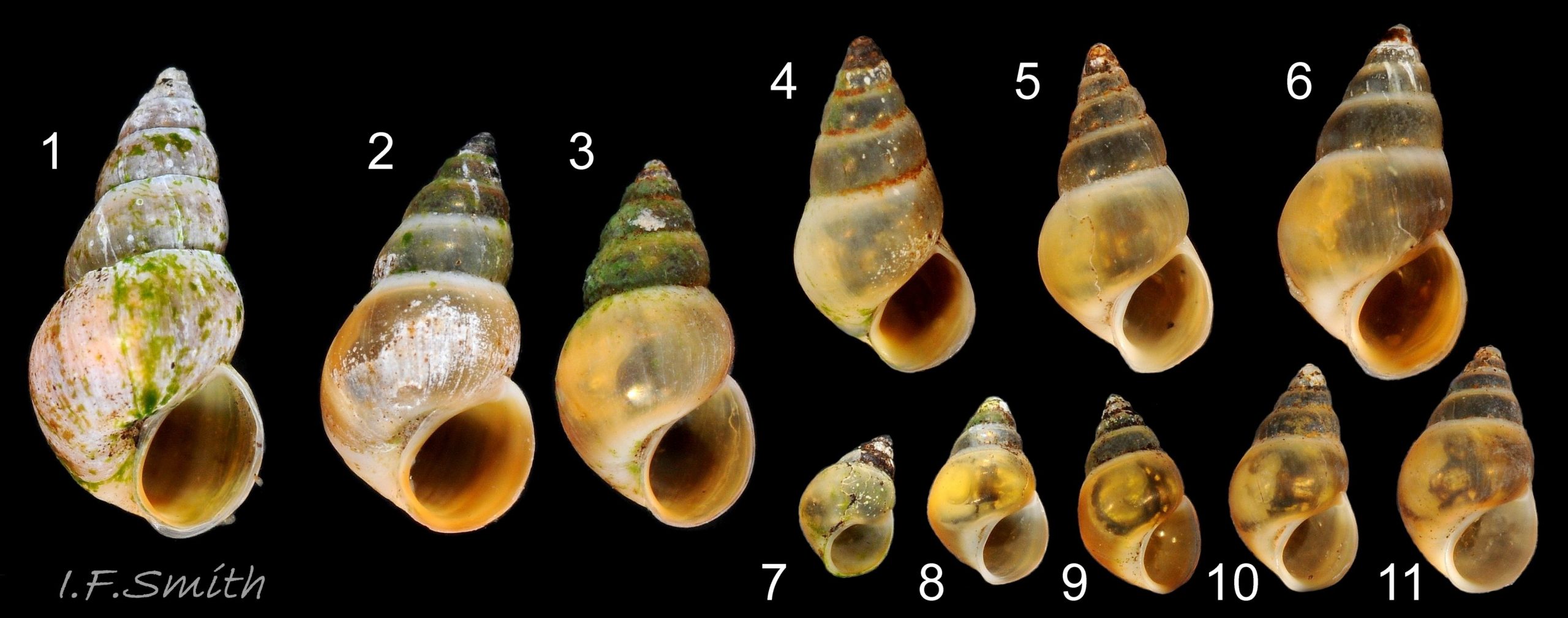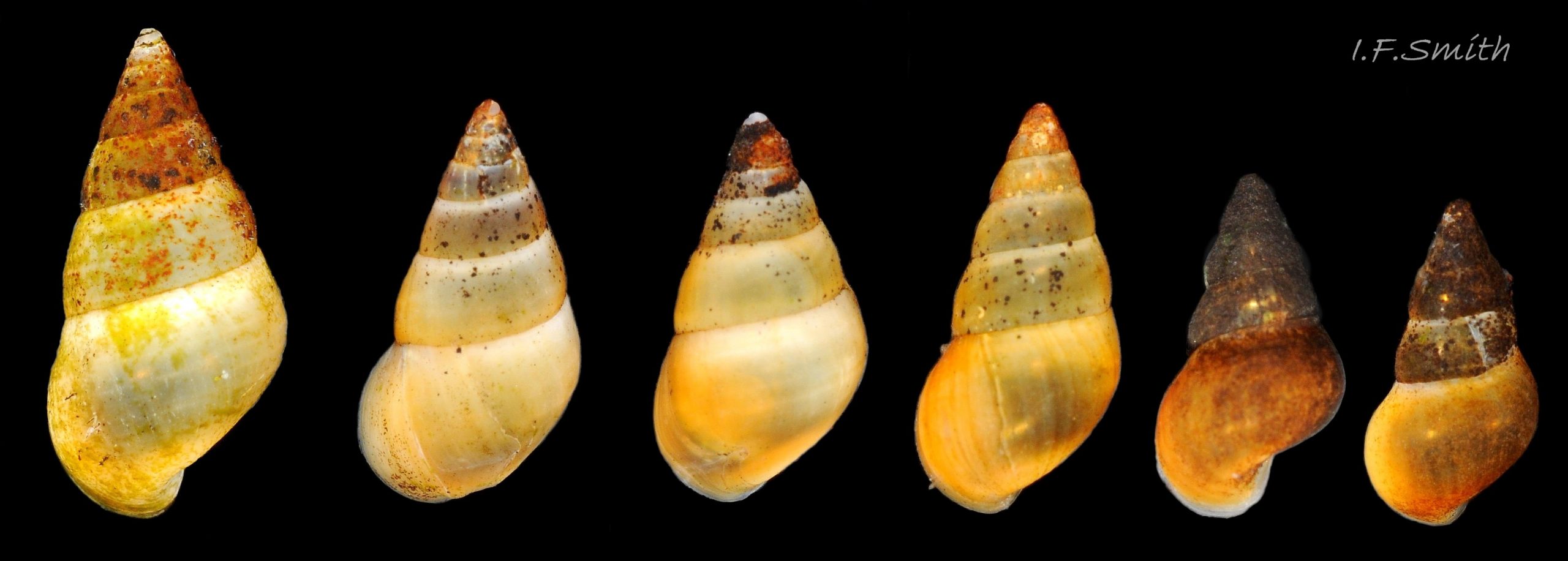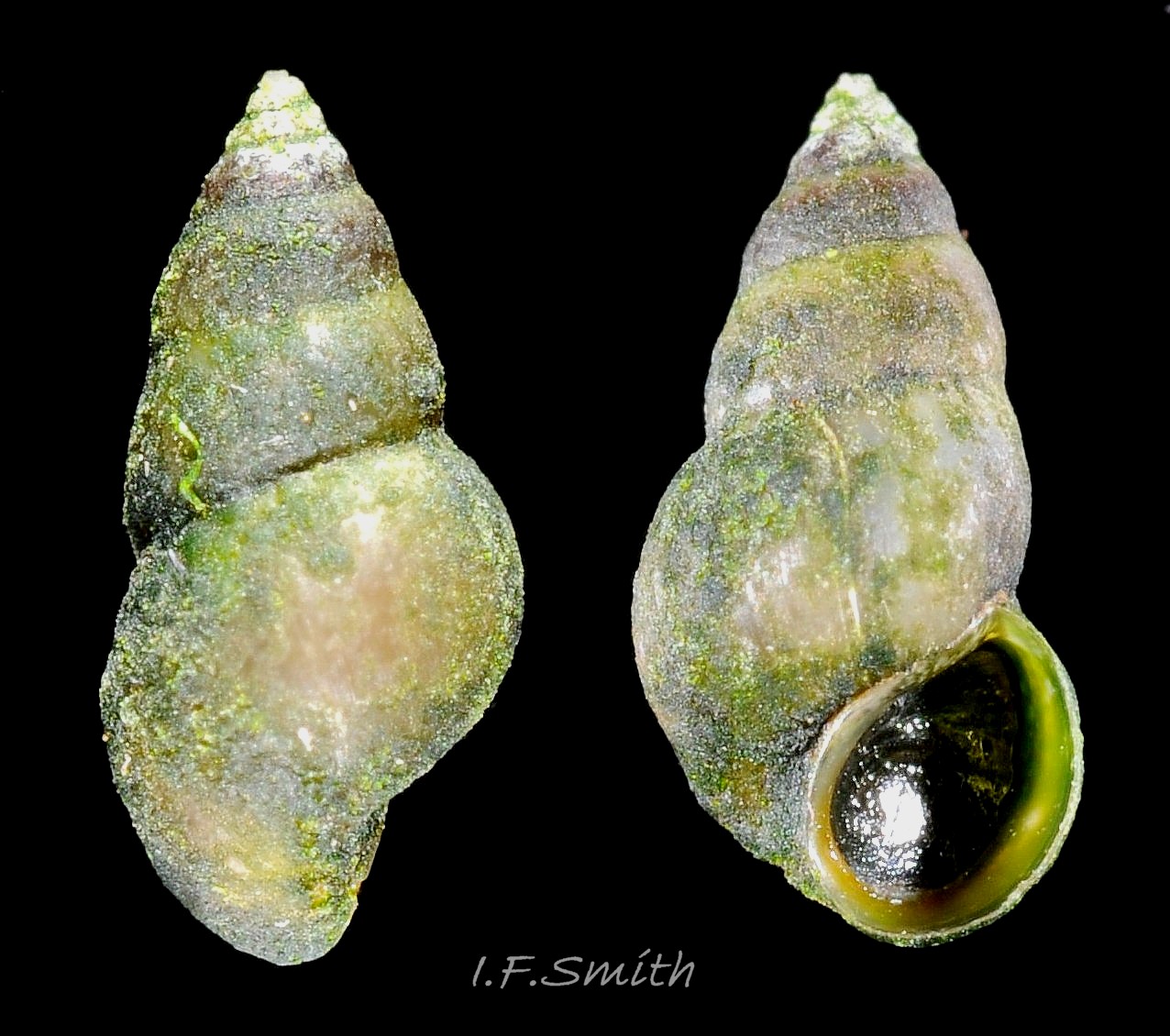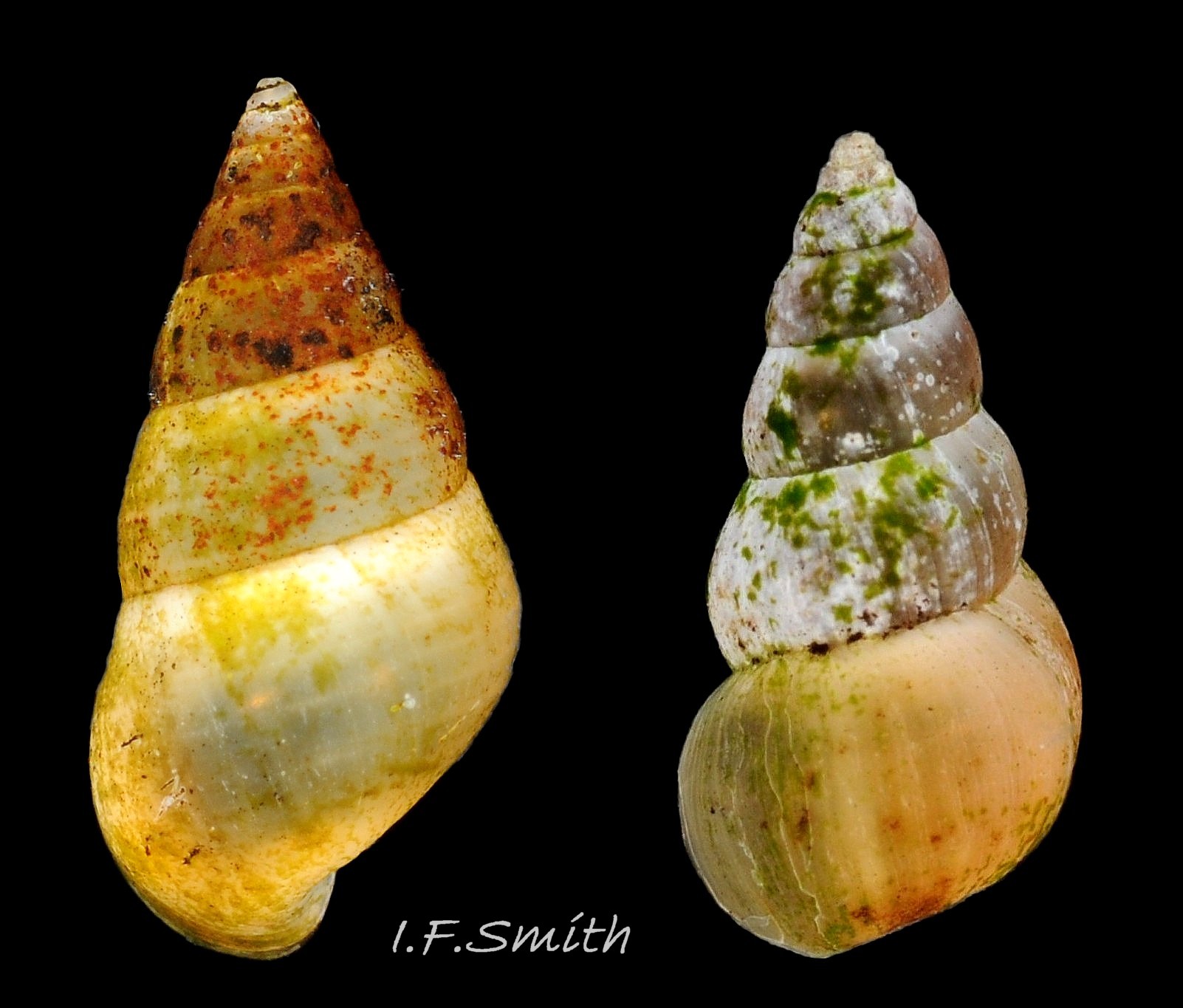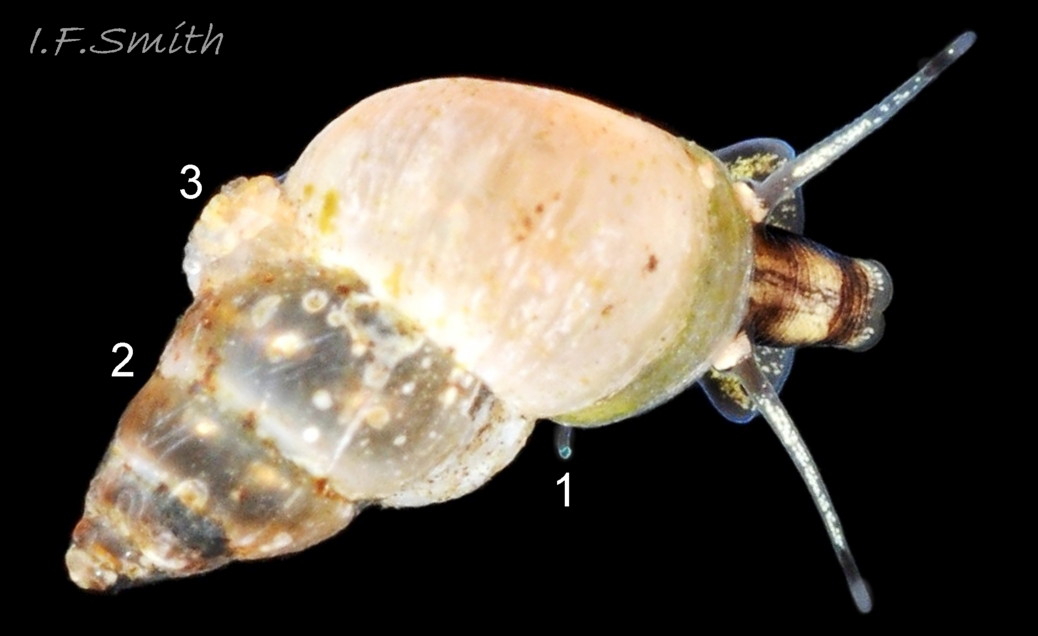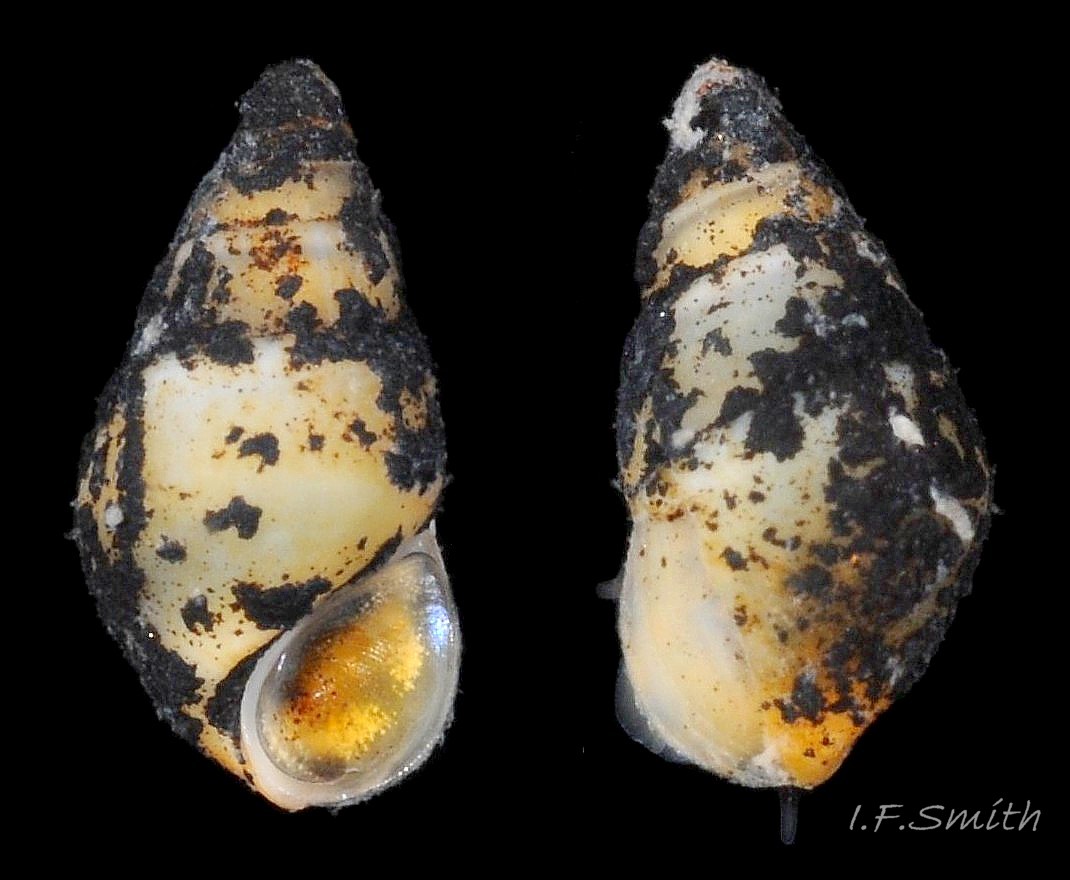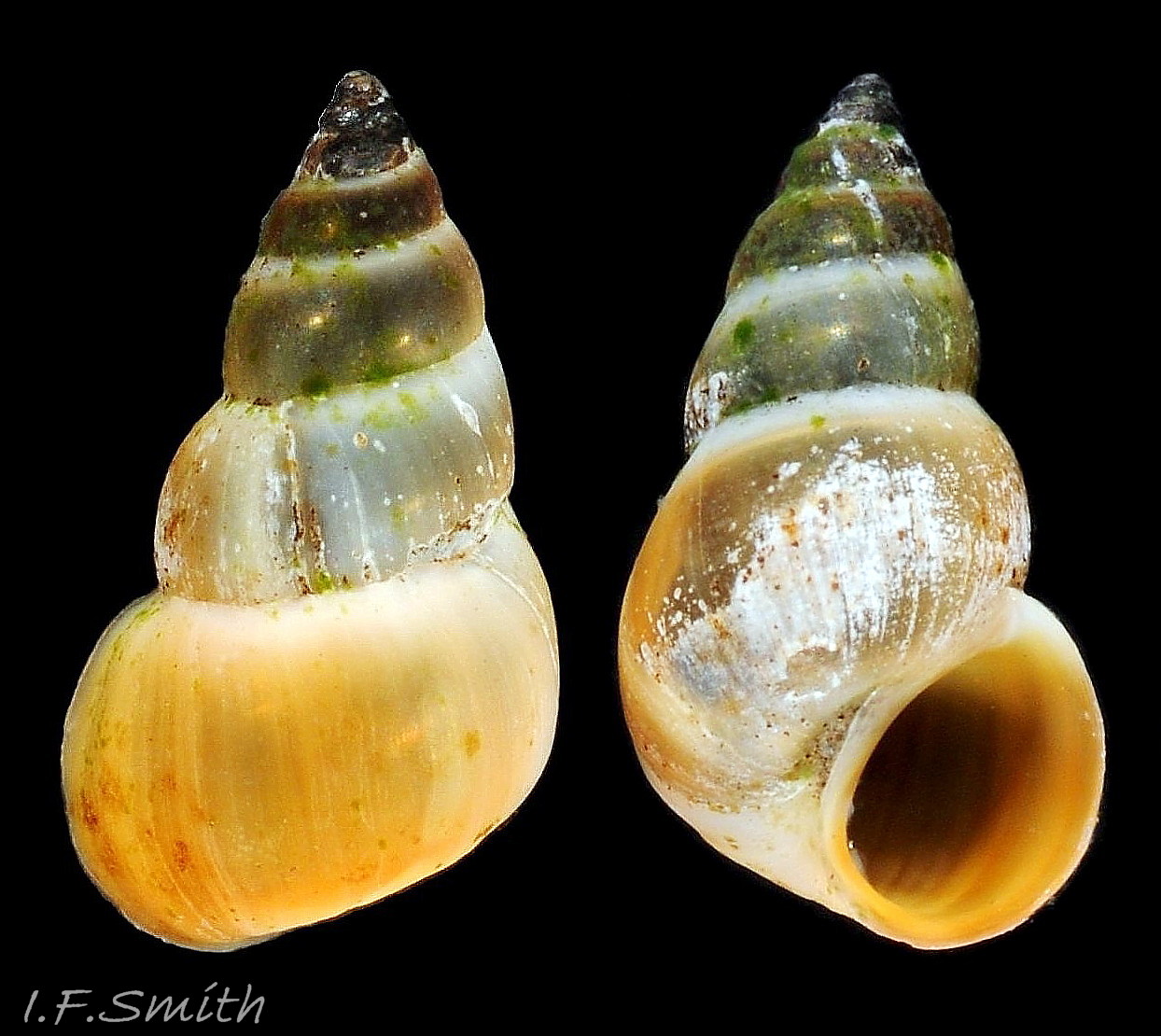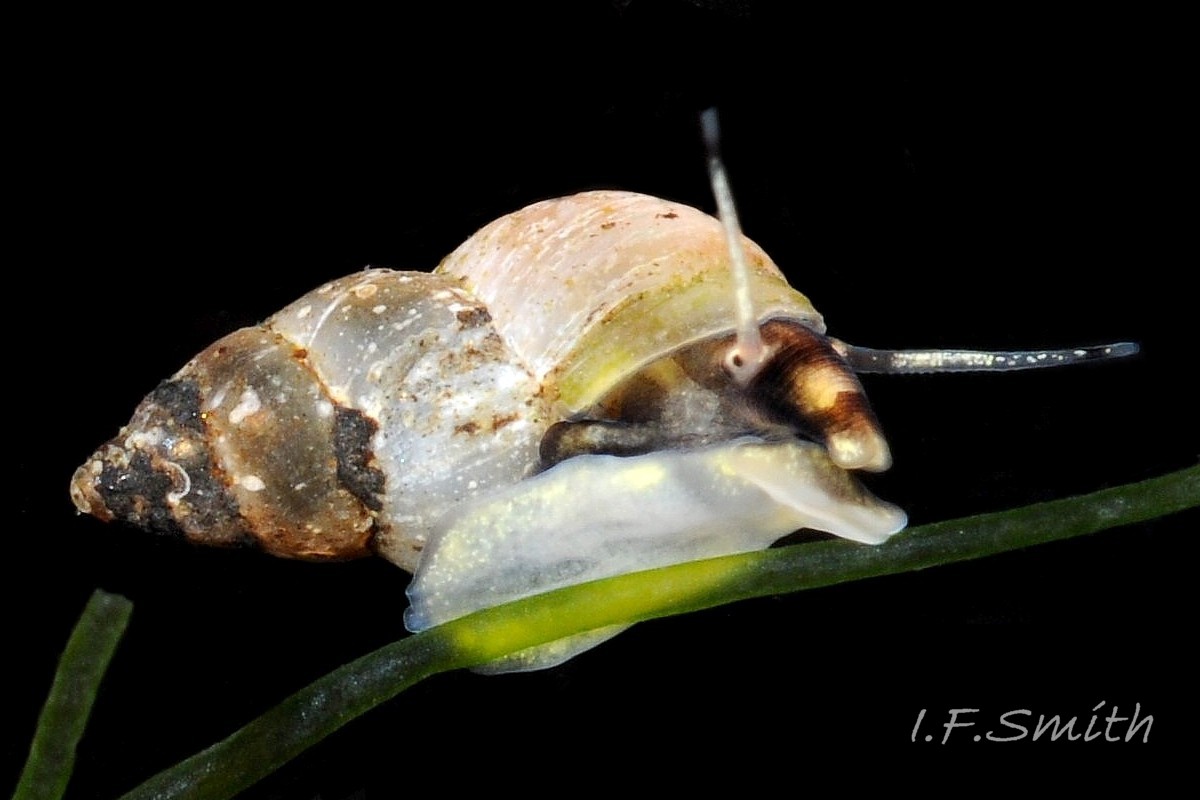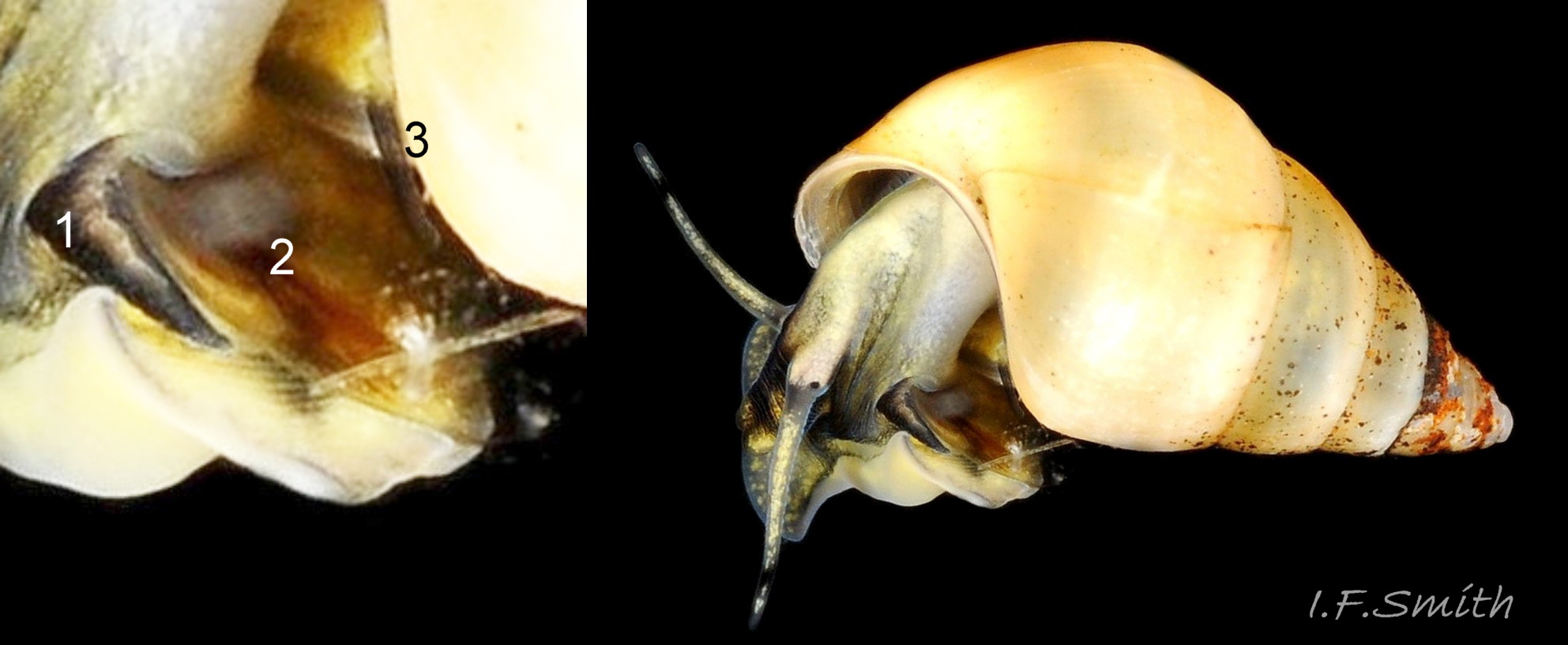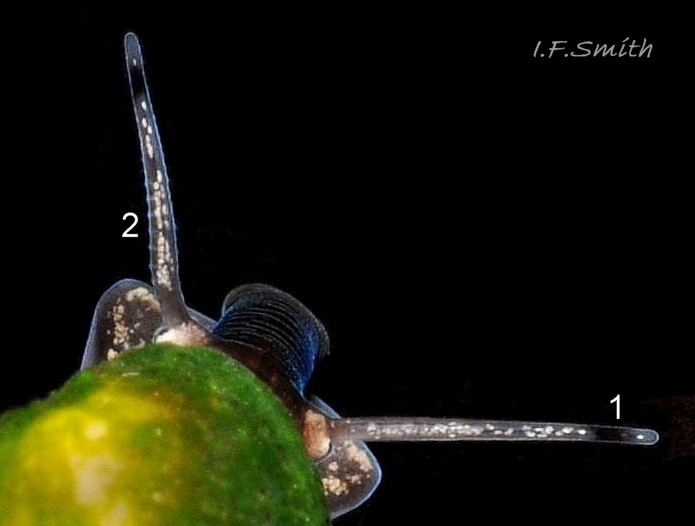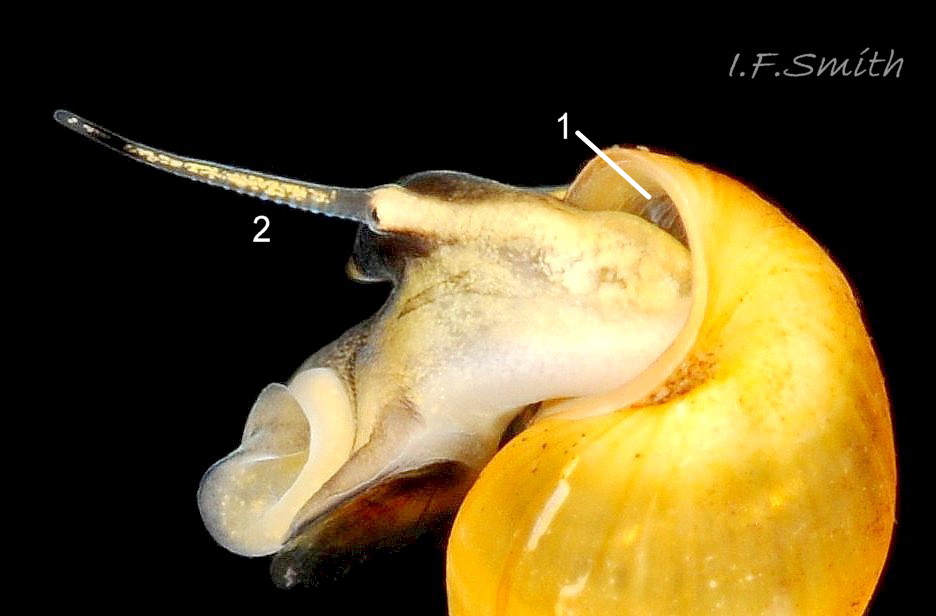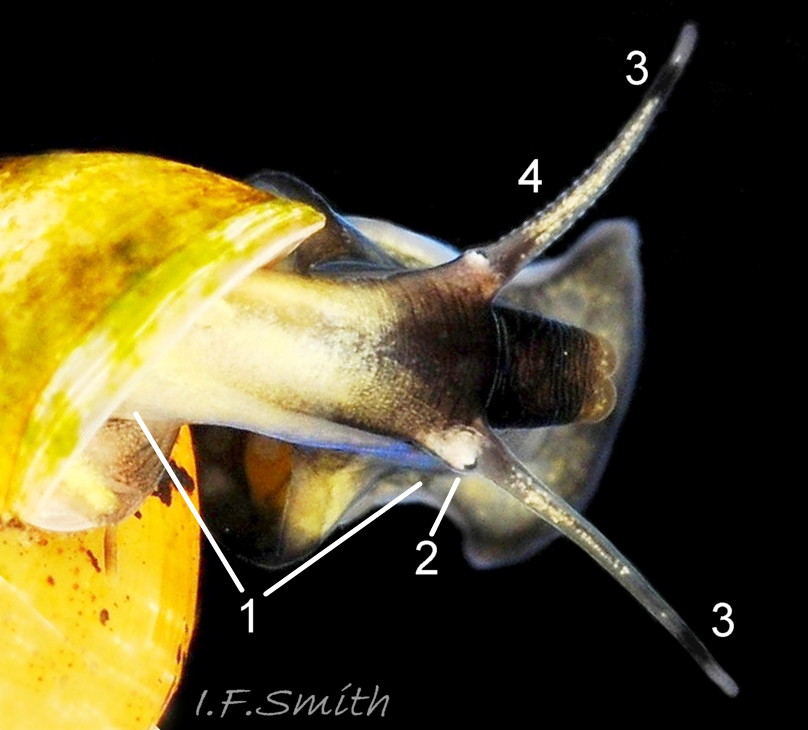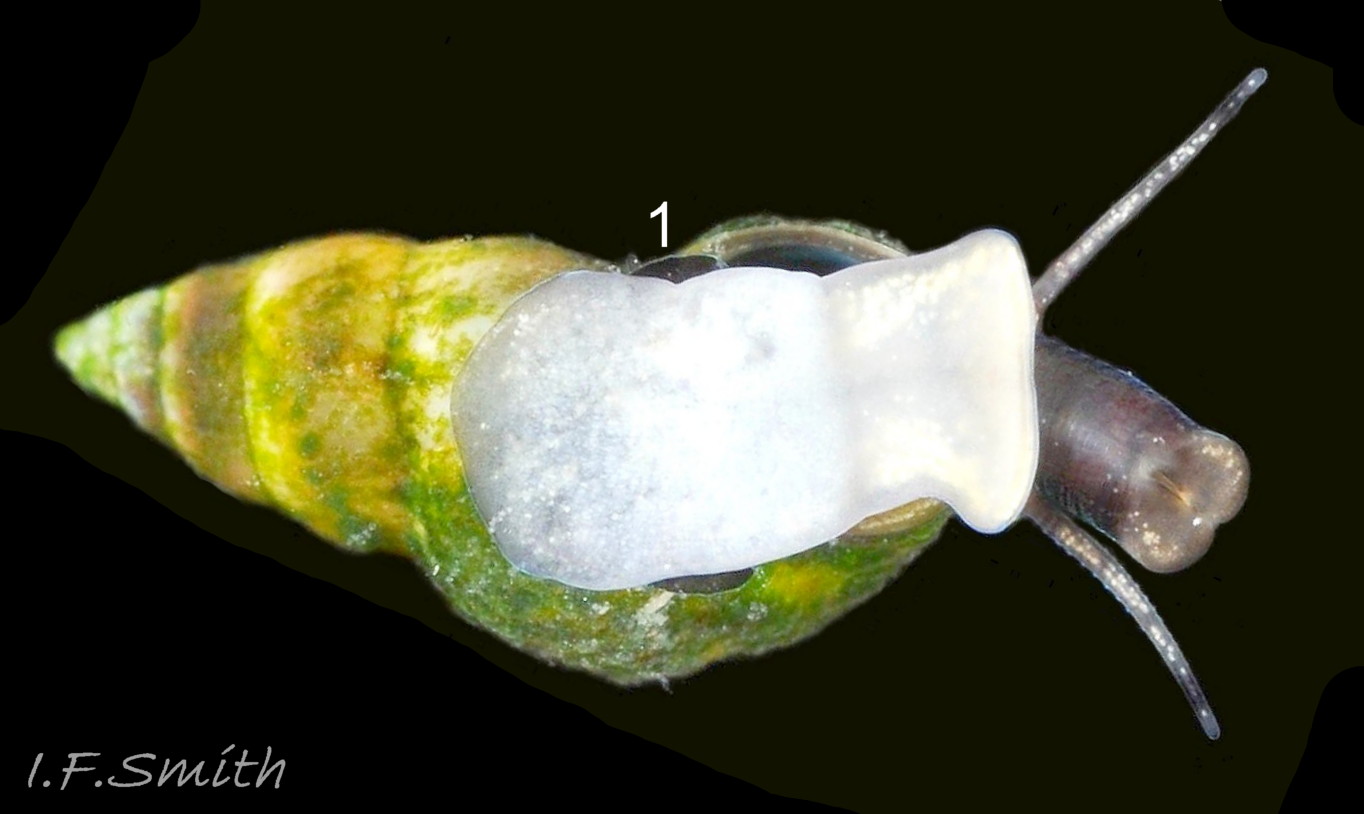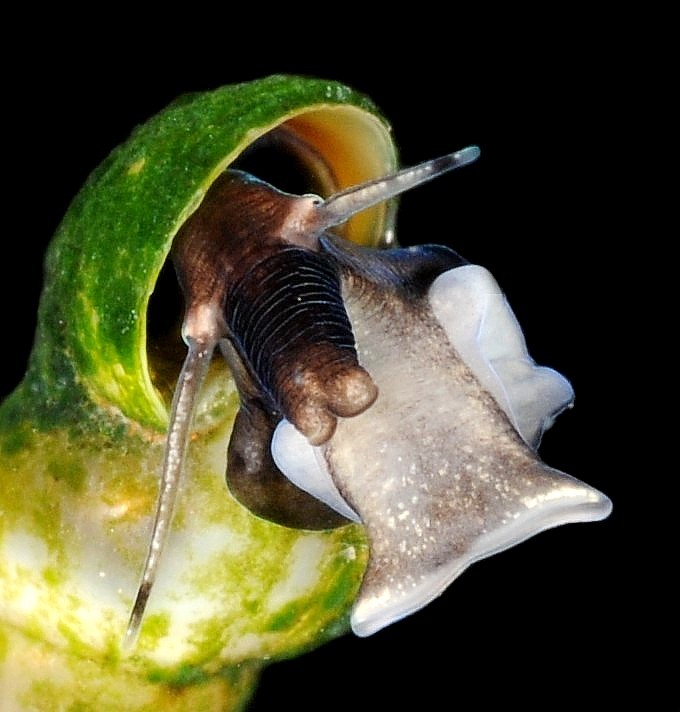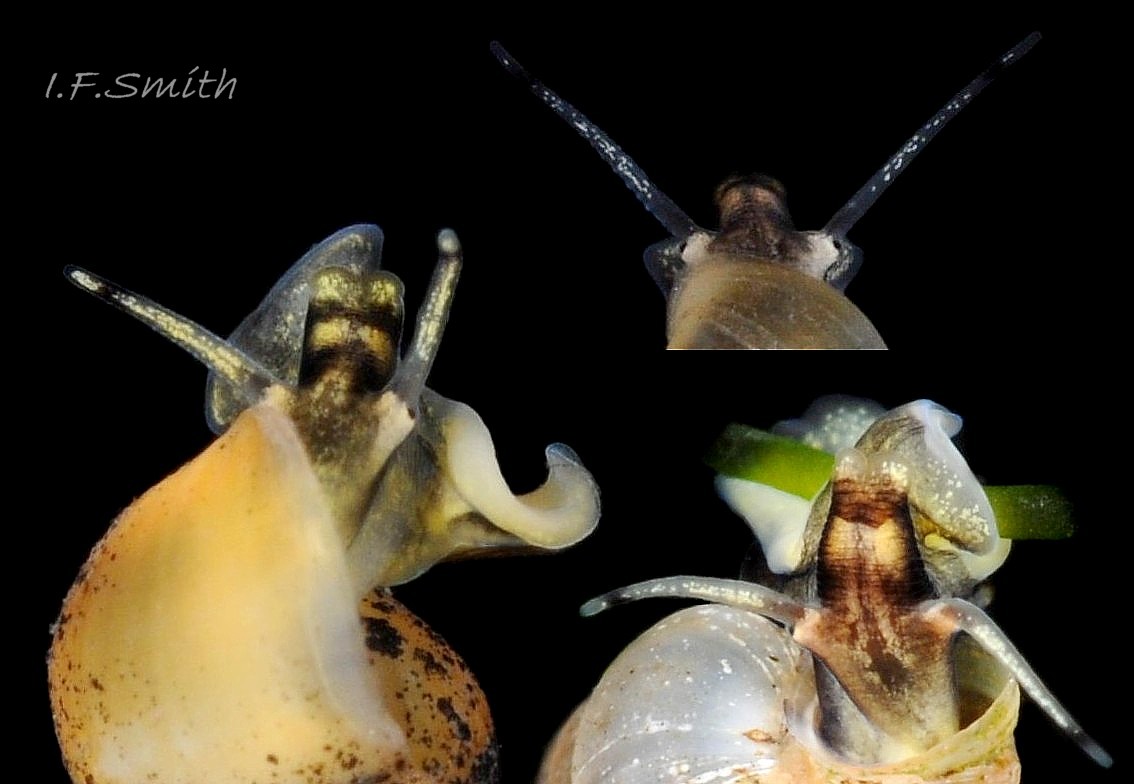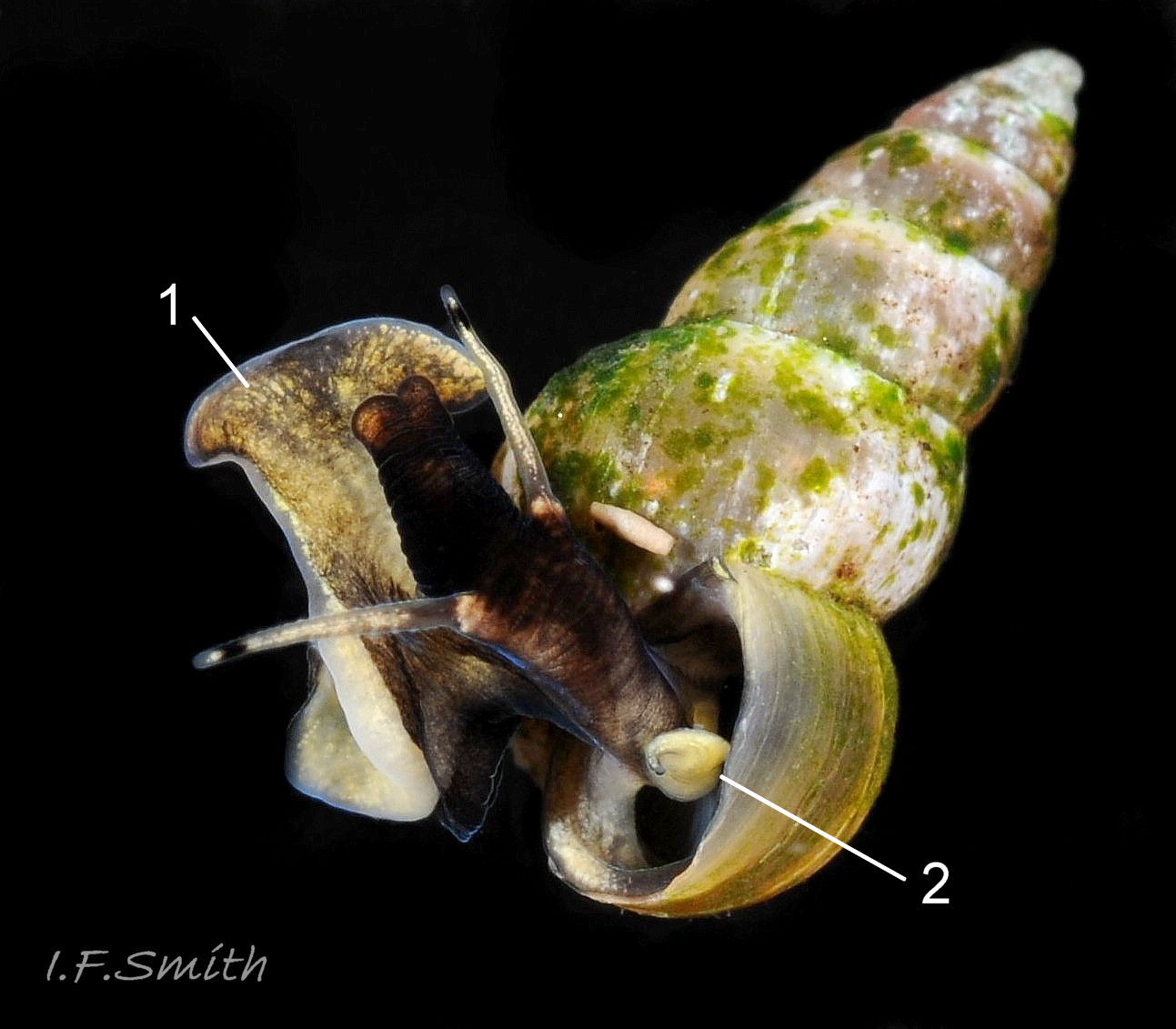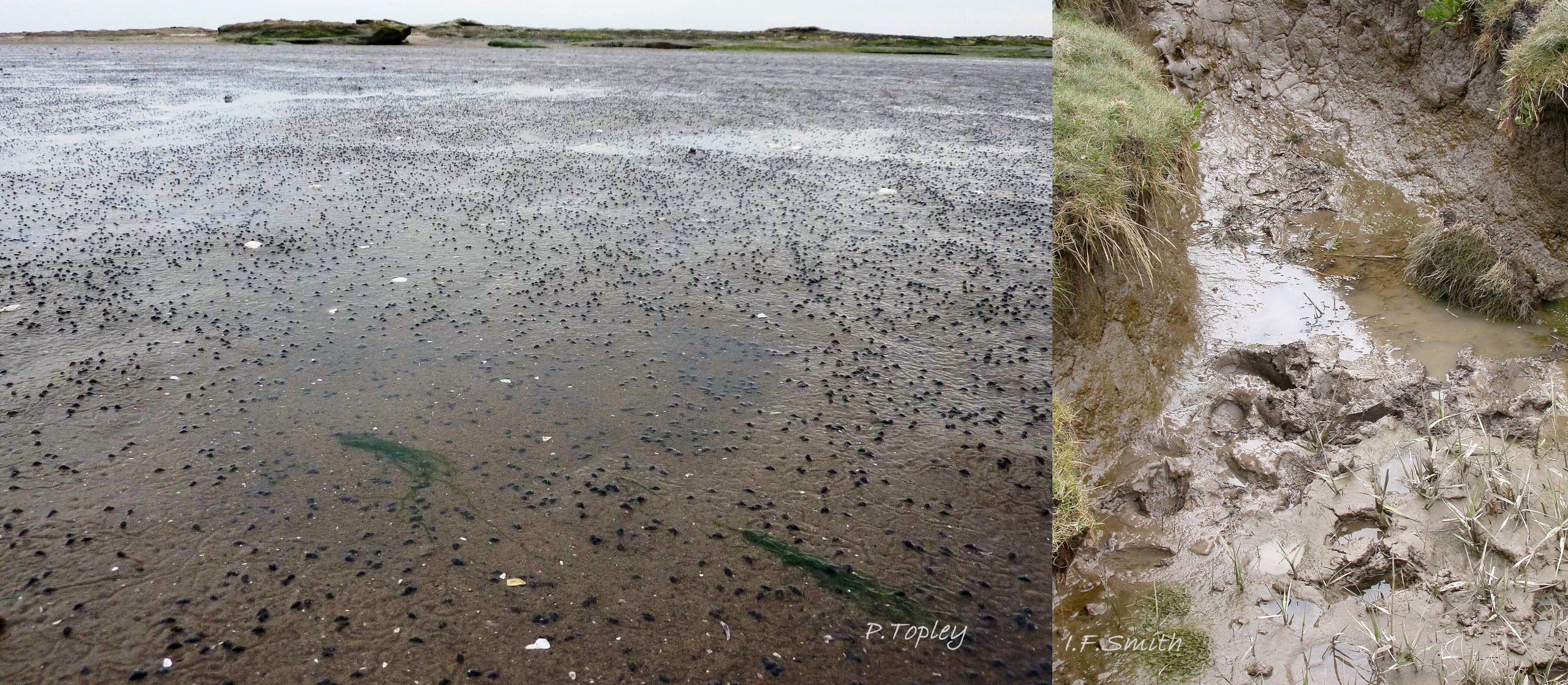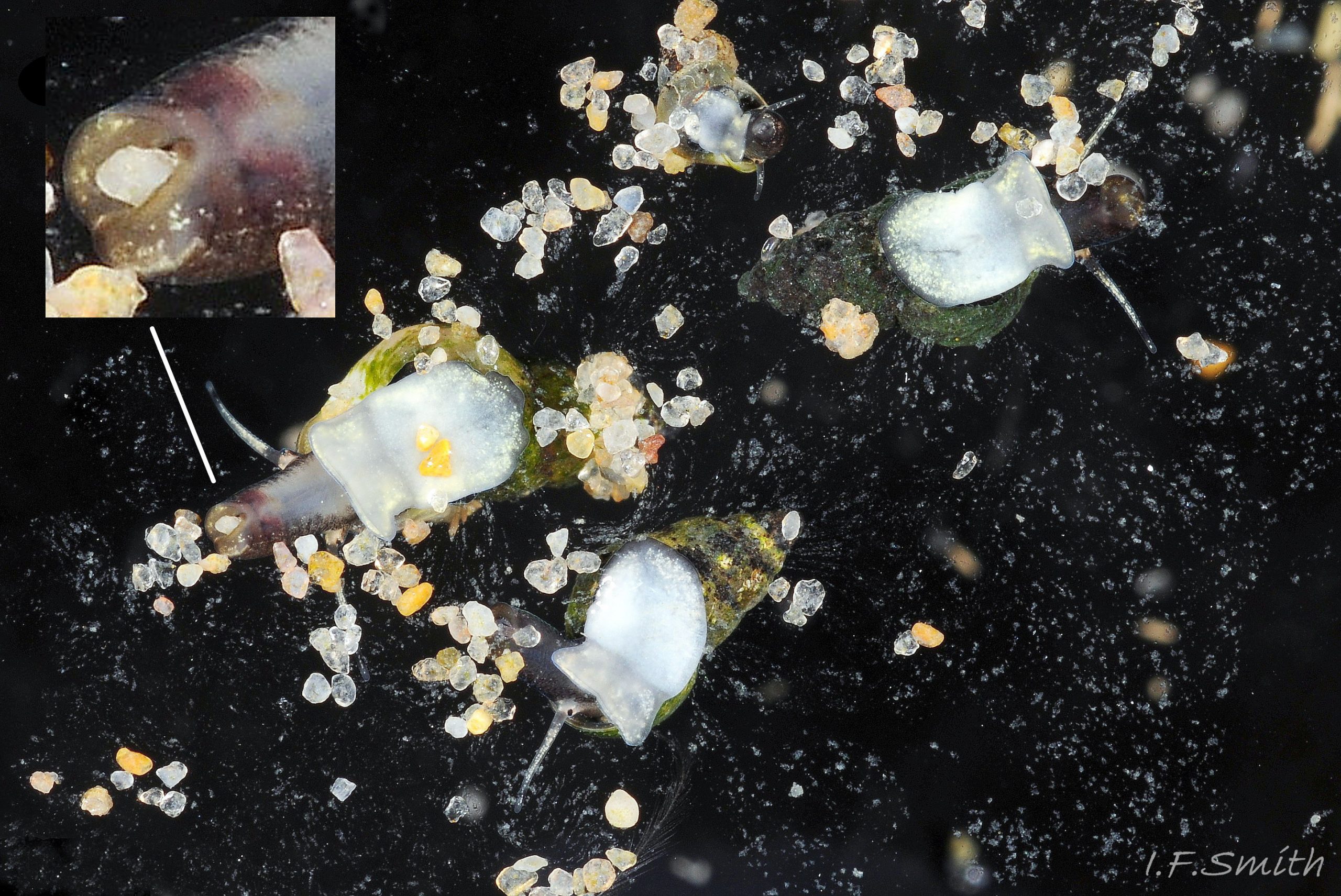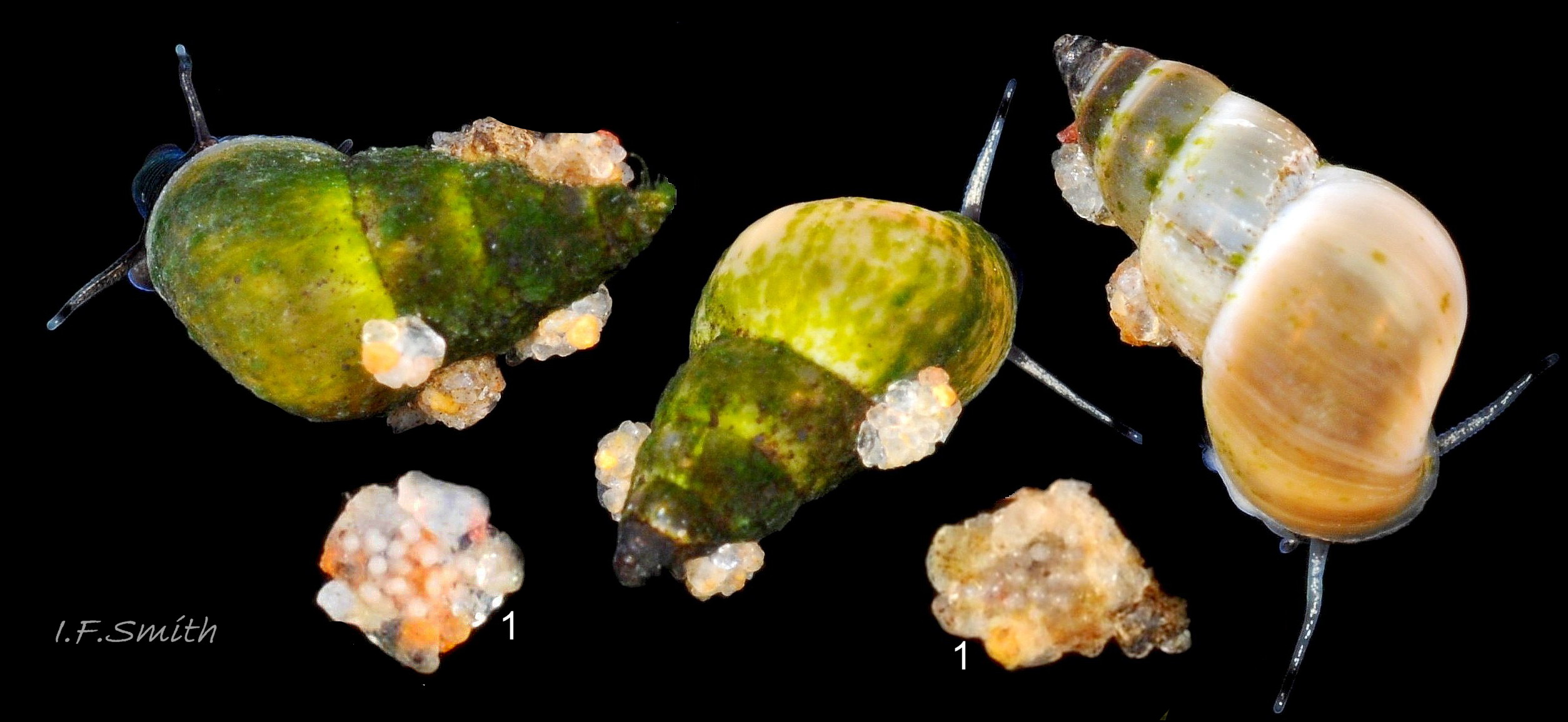Click image to enlarge with full caption. Main text below slider.
Peringia ulvae (Pennant, 1777)
Synonyms:Turbo ulvae Pennant, 1777; Hydrobia ulvae (Pennant, 1777); Paludestrina ulvae (Pennant, 1777); Paludina ulvae (Pennant, 1777); Rissoa ulvae (Pennant, 1777); Sabanaea ulvae (Pennant, 1777); Hydrobia stagnalis (some authors); Paludestrina stagnalis (some authors); Rissoa barleei Jeffreys;
Current taxonomy: WoRMS www.marinespecies.org/aphia.php?p=taxdetails&id=151628
Vernacular names: Laver spire shell; Laver wreath shell [Pennant]; Cogwrn y lafwr [Welsh];
GLOSSARY BELOW
Shell description
Usually up to 6 mm high, exceptionally 10 mm. Conical, body whorl proportion declines with growth from about 66% of 2mm high shell to about 50% of 6mm high shell 01 Peringia ulvae, but shape can vary independently of size 02 Peringia ulvae & 03 Peringia ulvae . No sculpture, surface smooth, unless encrusted or eroded 04 Peringia ulvae . Many sources , such as Graham (1988) and Fish & Fish (1989), state that whorls are almost flat in profile, but deep sutures and tumid whorls predominate in some populations 05 Peringia ulvae and it is this form which is illustrated by Pennant (1777) in his original description from the Dee Estuary in Wales 08 Peringia ulvae . Spire may be slightly translucent, revealing dark body inside 06 Peringia ulvae . Whitish-brown, yellow-brown to dark brown 02 Peringia ulvae (photos in water, duller in air). Surface may have green 04 Peringia ulvae , black 07 Peringia ulvae , brown or reddish 05 Peringia ulvae encrustations from the environment. Aperture about 55% of 2mm high shell, about 40% of 6mm high shell 01 Peringia ulvae ; acute adapical angle 07 Peringia ulvae . Tear-shaped spiral operculum 07 Peringia ulvae , often concealed by overlapping opercular lobe when creeping 09 Peringia ulvae . No open umbilicus, but usually small closed umbilical groove 08 Peringia ulvae .
Body description
Flesh yellowish/whitish grey, marked black/brown and yellow/white 10 Peringia ulvae.
Long translucent whitish to greyish cephalic tentacles with yellow or white pigment flecks and black subterminal band 11 Peringia ulvae . Left tentacle shorter with enlarged sensory cilia in oblique rows 12 Peringia ulvae . Eye on anterior of yellowish or pinkish white patch 13 Peringia ulvae at base of tentacle. Bifid extendible trunk-like snout 14 Peringia ulvae with transverse furrows 15 Peringia ulvae . Some snouts brown-black with light tip 15 Peringia ulvae , others patterned with transverse bands 16 Peringia ulvae .
Upper surface of foot pale grey with yellow or white mottling 17 Peringia ulvae ; anterior edge bilaminate 15 Peringia ulvae . Sole translucent white, sometimes showing freckles of upper surface 17 Peringia ulvae . Foot anterior can expand into prehensile lobes 17 Peringia ulvae .
Single small pallial tentacle 06 Peringia ulvae on right. Large yellow-flecked sickle-shaped penis behind head of male 19 Peringia ulvae . Adult female 10 Peringia ulvae. and juveniles lack visible organ behind head when body fully extended. Ovipositor 13 Peringia ulvae on right side of female. Tip of grey ctenidium occasionally seen when body fully extended 12 Peringia ulvae .
Key identification Features
Peringia ulvae (Pennant, 1777)
1) Adapical angle of aperture acute 07 Peringia ulvae . Maximum height 6 mm, occasionally 10 mm.
2) Translucent tentacles with black subterminal band and, usually, many yellow/ white pigment flecks 11 Peringia ulvae . Left tentacle thicker and less smooth than right tentacle 12 Peringia ulvae .
3) Salinity 5-40 p.p.t., usually estuarine mudflats or saltings with open tidal access.
Similar species
Potamopyrgus antipodarum (J.E. Gray, 1843)
1) Adapical angle of shell aperture rounded 04 Potamopyrgus antipodarum . Maximum height 5.5 mm, rarely 7 mm.
2) Translucent grey tentacles often with fine white medial line, no subterminal black mark and few/no white flecks apart from basal patch in front of eye 05 Potamopyrgus antipodarum .
3)Mainly in flowing fresh water, but also in brackish ditches and lagoons to 17 p.p.t. salinity.
Ecrobia ventrosa (Montagu, 1803)
www.habitas.org.uk/molluscireland/species.asp?ID=181
1) Adapical end of shell aperture rounded. Maximum height 4.5 mm.
2) Tentacles lack black transverse band, but may have longitudinal dusky streak near tip.
3) Lagoons, no opening to sea, seawater seepage in at high tide, salinity 1-36 p.p.t., with soft substrate & vegetation. (Sometimes P. ulvae found intermingled with E. ventrosa.)
Hydrobia acuta neglecta Muus,1963
www.habitas.org.uk/molluscireland/species.asp?ID=94
1) Adapical end of aperture acute. 4 mm maximum height.
2) Tentacles grey of varying darkness; tips covered with long thin black cone except for paler extreme apex and often a pale intrusion into base of cone dorsally.
3) Lagoons, no opening to sea, salinity 10-35 p.p.t., with soft substrate & vegetation.
Assiminea grayana Fleming, 1828
1) Adapical end of aperture acute 01 Assiminea grayana . Maximum height 6 mm.
2) Short blackish grey tentacles with eye visible dorsally near tip 08 Assiminea grayana .
3) Near high water mark on saltings and tidal rivers, usually moist, but not submerged except just after high spring tide or flooding.
Melarhaphe neritoides (Linnaeus, 1758)
1) Adapical angle of shell aperture acute 02 Melarhaphe neritoides
2) Long cephalic tentacles, grey-black dorsally with thin pale median line 10 Melarhaphe neritoides .Eye centrally in large whitish disc at base of long tentacles 06 Melarhaphe neritoides
3) At and above EHWS on exposed rocky shores 13 Melarhaphe neritoides
Habits and Ecology
Abundant on firm bare intertidal wet muddy sand and mud on estuaries and saltings at salinities 5- 40 p.p.t.; individuals may struggle to adjust to very large rapid salinity changes. Also on gravel or broken clay-slate with silt, on Ulva, and in pools with bare soft substrate; usually with tidal access. Often at densities 5 000 –9 000 /sq.metre, and occasionally to 42 000 /sq.metre. At all shore levels, varying with local substrate conditions; avoids putrid mud lacking oxygen, and semi-liquid mud (e.g. parts of Severn Estuary). If on open coast, usually some freshwater inflow.
Crawls when substrate moist or covered in calm water. No waves detectable on sole when crawls horizontally; probably moves by means of cilia on sole. Direct monotaxic waves detectable on posterior of foot when crawls up vertical glass. Leaves 2 mm wide track with mucus trail on sand or mud. Swings trunk-like snout from side to side while crawling to feed on small organic particles, diatoms and bacteria. Individual grain of sand can be held by bifid snout while radula grazes it 21 Peringia ulvae . In soft mud, lies buried horizontally except for aperture from which body extends. When submerged, may float feeding under water surface with aid of a mucus raft 21 Peringia ulvae which traps diatoms etc. from the neuston. Rafting snails, and dried juveniles with air trapped in aperture, dispersed by currents and waves, so colonises rapidly, e.g. upriver if drought causes short term increase in salinity. When mud and pools dry out, buries self and becomes dormant. Also buries self if water turbulent. Breeds all months, peak varies with location. Spawn 22 Peringia ulvae ; gelatinous hemispherical masses covered in sand, containing up to 25 eggs floating in albuminous fluid, attached to shells of other individuals; up to 90% carry spawn masses at peak breeding times. Short veliger stage, sometimes suppressed (?) or escapes capture as stays near substrate (?). Velum small and only slightly bilobed. Each female lays about 300 eggs in a breeding season; small number in comparison with other species e.g. Littorina littorea, but comparatively good survival rate of about 10% beyond 1mm shell height. Maximum growth rate April-July. Most die before 2 years old.
Important part of the ecosystem in estuaries and saltings, providing food for birds, fish and many parasites, altering the substrate with its spindle-shape faecal pellets and affecting the abundance of the micro-organisms it feeds on. Associated fauna; other euryhaline spp. such as Macoma balthica and Scrobicularia plana. Not with terrestrial spp. except when these colonise dried out mud with dormant P. ulvae buried in it. Sometimes close to, but not usually intermingled with, Assiminea grayana at HWS level of saltings (no intermingling found on Dee Estuary, but possible report from Lincolnshire).
Distribution and status
North Norway to Senegal, including Baltic and Mediterranean. GBIF map www.gbif.org/species/4361879 . Abundant on estuaries and saltings all round Britain and Ireland. NBN UK map species.nbnatlas.org/species/NHMSYS0001702153
Links and references
Fretter, V. and Graham, A. 1962. British prosobranch molluscs: their functional anatomy and ecology. London, Ray Society. (Has index of species.)
Fretter, V. and Graham, A. 1994. British prosobranch molluscs: their functional anatomy and ecology. Revised edition. London, Ray Society. (Much new material but lacks index of species.)
Graham, A. 1988. Molluscs: prosobranch and pyramidellid gastropods. Synopses of the British Fauna (New Series) no.2 (Second edition). Leiden, E.J. Brill/Dr. W. Backhuys. 662 pp.
Green, J. 1968. The biology of estuarine animals. London. Sidgwick & Jackson.
Pennant, T. 1812 British Zoology 4. London (Original description from Dee Estuary) p. 299 https://archive.org/details/britishzoolog04penn/page/299/mode/1up?view=theater Plate LXXXIX fig. 7 http://archive.org/stream/britishzoolog04pennpage/558/mode/2up
Rowson, B., Powell, H., Willing, M., Dobson, M. and Shaw, H. 2021. Freshwater snails of Britain and Ireland. Telford, FSC.
Van Haaren, T., Worsfold, T.M., Stelbrink, B., Collado, G.A., Gonçalves, I.C.B., Serra, W.S., Scarabino, F., Gittenberger, A. & Gittenberger, E. 2021. Heleobia charruana (Gastropoda, Truncatelloidea, Cochliopidae), a South American brackish water snail in northwest European estuaries. Basteria 85 (1): 82–91. Leiden. https://www.researchgate.net/publication/351248434_Heleobia_charruana_Gastropoda_Truncatelloidea_Cochliopidae_a_South_American_brackish_water_snail_in_northwest_European_estuaries.
Yonge, C.M. and Thompson, T.E. 1976. Living marine molluscs. London.
Glossary
‰ = (salinity) parts salt per thousand parts water (brackish < 30‰).
adapical = towards the apex of the shell.
aperture = mouth of gastropod shell; outlet for head and foot.
bifid = divided into two parts by a cleft.
cephalic = (adj.) of the head.
cilia = (sing. cilium) microscopic linear extensions of membrane which can act as sensory organs or move in rhythmic waves to create locomotion.
ctenidium = comb-like molluscan gill; usually an axis with a row of filaments either side.
direct = (of waves) moving over gastropod foot in same direction as snail travelling.
euryhaline = able to tolerate a wide variation in salinity.
mantle = (a.k.a. pallium) sheet of tissue which secretes the shell, covers the viscera and forms a cavity in gastropods.
monotaxic = (of waves) single series across whole width of gastropod foot.
neuston = community of micro-organisms living in the surface film of water.
operculum = horny plate used to close shell aperture.
opercular = (adj.) of the operculum.
ovipositor = an unpigmented tract on the right side of a female’s body which carries ova out of the mantle cavity for deposition (usually on the shell of another P. ulvae).
pallial tentacle = tentacular extension of the edge of the pallium (mantle).
penes = plural of penis, male copulatory organ.
radula = ribbon of chitinous teeth extruded on a tongue-like structure (odontophore) to rasp food.
subterminal = a short distance from the end.
suture = groove or line where whorls adjoin.
tumid = bulging, distended, swollen, distinctly convex.
umbilicus = cavity up axis of some gastropod shells, open as a hole or chink on base of shell, often sealed over.
umbilical chink = narrow slit-like umbilicus, often inconspicuous.
veliger = shelled larva of marine gastropod or bivalve mollusc which swims by beating cilia of a velum (bilobed flap
